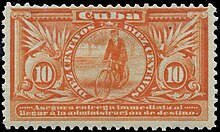
The depiction of bicycles on stamps began in 1899 with a Cuban special delivery stamp, although unofficial (local or cinderella) issues had been previously released in Germany (1887/8), in the United States (1894), and in Australia (1896). The number of bicycle-related postal items (stamps, postal stationery, etc.) exceeds 30,000 as of 2024. As a thematic topic, bicycles are notable for the wide variety of subjects that they are used to illustrate.
Definition



The definition of what constitutes a bicycle stamp is open to interpretation. A bicycle stamp has one or more of the following characteristics:
- It depicts a human-powered cycling machine. This includes a whole (or part of) bicycles, tricycles, unicycles, toy cycles, tandems, rickshaws, exercise/standing bicycles, etc. It excludes powered or unpowered wheelchairs and motor-driven or motor-assisted cycling machines, e.g. motorcycles, mopeds.
- It depicts a bicycle or cyclist in a social context. For example, a cyclist in a street scene, cycling as an energy-efficient, green, mode of transport, or cycling promoting road safety.
- It depicts a building used specifically for cycling sport, i.e. a velodrome.
- It depicts a person notable for being a cyclist, e.g. a winner of the Tour de France, or cycling events at the Olympic Games.
- It depicts the process of manufacturing a bicycle, or a notable bicycle manufacturer (individual or firm).
- It depicts the word "bicycle" in the local language, even if the image of a bicycle is not included. The word triathlon without an image of a bicycle is excluded.
The following types of material are excluded (although they may also be collected by bicycle stamp enthusiasts):
- Postal stationery, e.g. a postcard depicting a bicycle with a non-bicycle stamp affixed.
- Cinderella, local, private or personal issues, i.e. unofficial stamps.
- Non-postal stamps, e.g. revenue stamps such as the French 1940s "Impôt sur les vélocipèdes".
- Stamps issued by non-existing/unrecognized countries and/or in excess of actual postal requirements.
Early issues
The first bicycle stamp of the 20th century was a 1900 stamp issued for local postal delivery during the siege of Mafeking, depicting Cadet Sgt. Major Goodyear on a bicycle. The United States issued a special delivery bicycle messenger stamp in 1902. Bulgaria issued a cycling stamp as part of a set commemorating the Balkan games of 1931. In 1935 the USSR issued a bicycle stamp to commemorate the World Spartacist Games. Denmark issued a stamp showing King Christian X on horseback as part of his silver jubilee celebrations in 1937; in the background of the street scene are three cyclists.
These early issues illustrate the wide variety of subjects depicted on bicycle stamps.
-
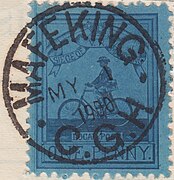 Siege of Mafeking local stamp 1900
Siege of Mafeking local stamp 1900
-
 United States special delivery bicycle messenger stamp 1902
United States special delivery bicycle messenger stamp 1902
-
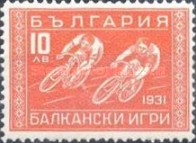 Bulgaria Balkan games racing cyclists stamp 1931
Bulgaria Balkan games racing cyclists stamp 1931
-
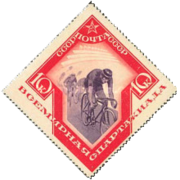 USSR World Spartacist Games 1935
USSR World Spartacist Games 1935
-
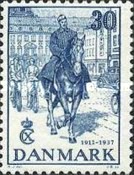 Denmark street scene 1937
Denmark street scene 1937
Depiction of cycle sports

Cycle sports include:
- Indoor
- Cycle racing
- Velodromes
- Outdoor
- Event racing, e.g. cycling to raise money for charities
- Tour racing, e.g. the Giro d'Italia
Depiction of non-sport uses


Subjects depicted on non-sport bicycle stamps include:
- The history of the bicycle
- Bicycle industrial manufacturing
- Bicycle mail transportation and postal delivery
- Bicycles for commercial delivery
- People transportation e.g. by rickshaw
- Bicycle military use
- Bicycles as toys
- Bicycle tourism
- Bicycles in street scenes
- Bicycles to symbolize alternative, energy-efficient transport
- Bicycles depicting or encouraging road traffic safety
Bibliography
- Sudbury, Ronald F. (1976). The bicycle and the postage stamp. Batley: Harry Hayes. p. 62. ISBN 9780905222141.
- Sudbury, Ronald F. (1981). Stamp collecting for the cyclist. Batley: Harry Hayes. p. 60. ISBN 9780905222424.
- Mangin, Jean-Pierre; Geslin, René (1988). Le cycle et la poste (in French). Bar le Duc: J.-P. Mangin. p. 319. OCLC 465817564.
- Gindling, Dan (1997). Bicycle stamps: bikes and cycling on the world's postage stamps. Osceola, WI: Motorbooks International. p. 144. ISBN 9780933201781.
Notes
- A perfin meeting one or more of the characteristics is a valid bicycle stamp.
- Some collectors believe that the existence of human-powered parts, such as pedals and a bicycle chain, in the pictured bicycle should make the image acceptable as a bicycle stamp, even if the machine is power-assisted.
References
- Lowell, B. Cooper (1982). The Fresno and San Francisco bicycle mail of 1894. Louisville, KY: Hartmann. p. 134. ISBN 9780917528057.
- "History of the Bicycle Stamp" (PDF). New York Times - 1896. 1899-05-09. Retrieved 30 April 2024.
- Rehm, Arnoldt. "Welcome". Bicycle Philately. Retrieved 28 April 2024.
- "What to collect?". Bicycle Stamps Club. 2018. Retrieved 28 April 2024.
- Malone, Steve (1996). Illustrated bikes on stamps. Reprinted from Bicycling Magazine, April, 1995. p. 148.
- Rehm, Arnoldt. "What is a "bicycle stamp"?". Bicycle Philately. Retrieved 30 April 2024.
- Wiedman, Carl S. (1990). "Bicycles on postage stamps". The Canadian Philatelist. 41 (1): 30–36. Retrieved 15 August 2024.
- Salmon, Guy (1990). "An update on some French timbres fiscaux" (PDF). Bicycle Stamps Club Magazine (BS 8): 18. Retrieved 30 April 2024.
- Schapefhouman, Bert (1991). "Mafeking: The Mafeking Blues" (PDF). Bicycle Stamps Club Magazine (BS 11A): 11–15. Retrieved 28 April 2024.
External links
- Bicycle Philately: The home of bicycle stamps collectors
- Bicycle Stamps Club
- American Topical Association ATA
- British Thematic Association
| Topical stamp collecting | |||||||||||||||||||||||
|---|---|---|---|---|---|---|---|---|---|---|---|---|---|---|---|---|---|---|---|---|---|---|---|
Themes  |
| ||||||||||||||||||||||
| Organizations | |||||||||||||||||||||||